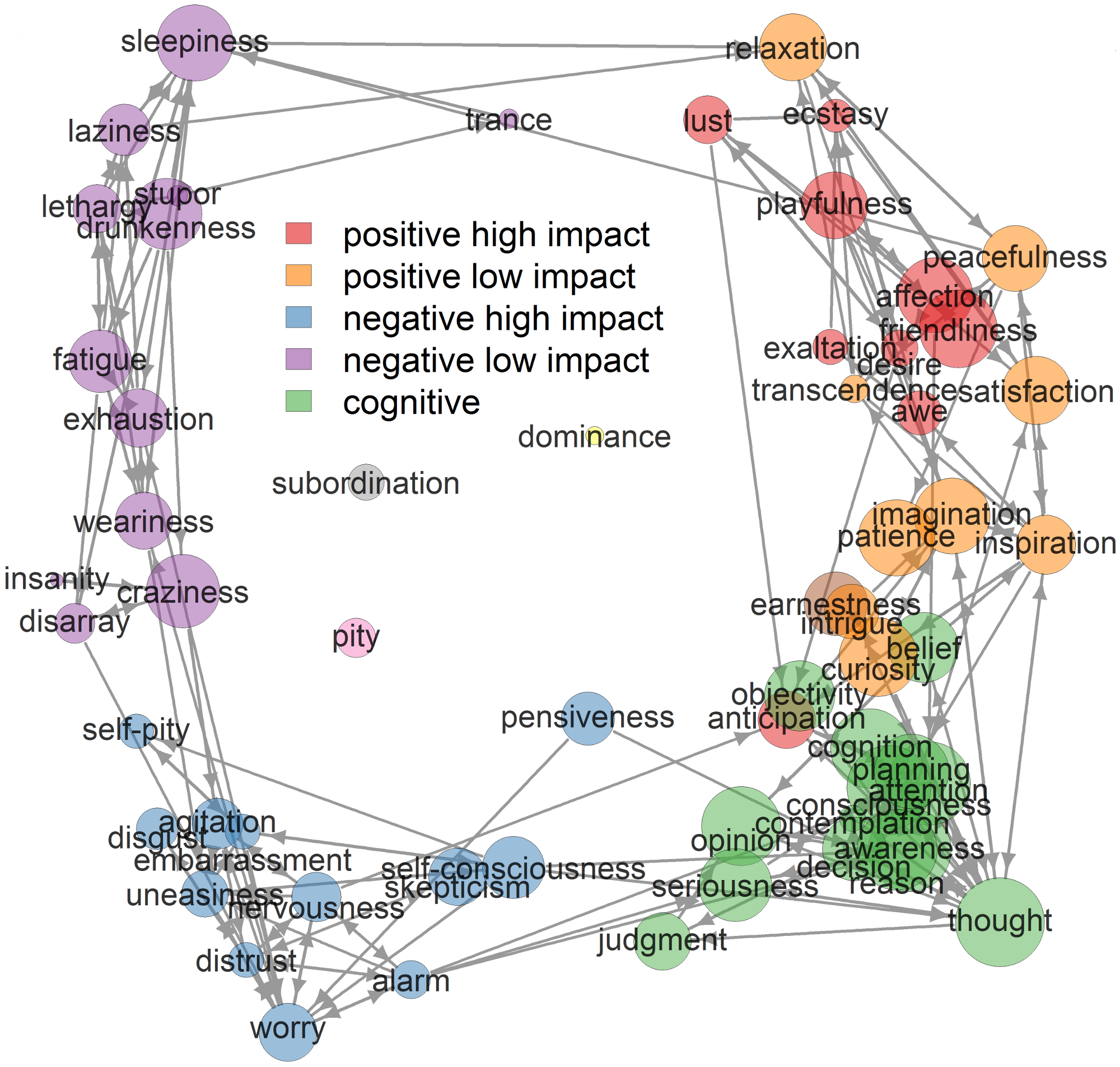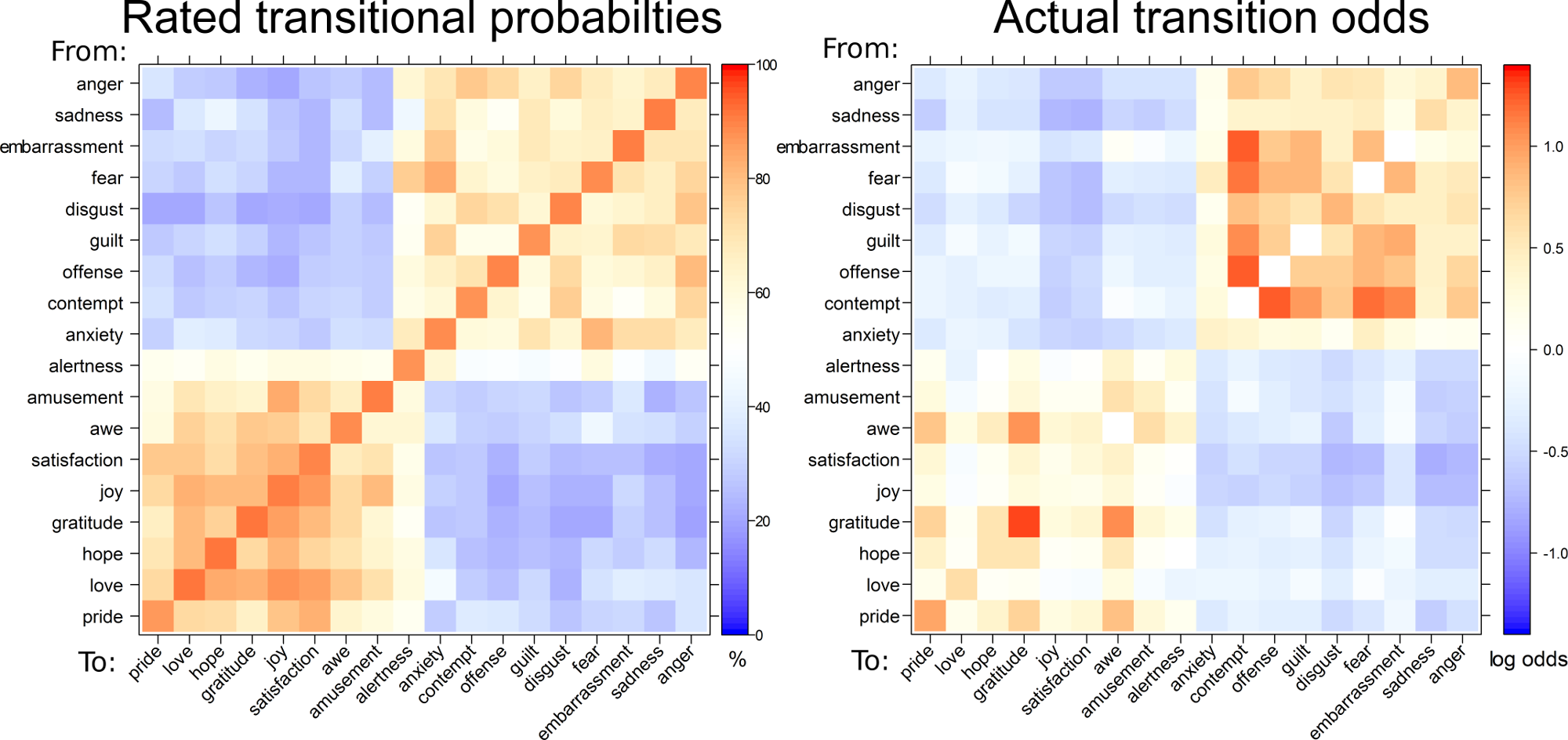Postings on science, wine, and the mind, among other things.
Intuition for other people's emotional dynamics
A pop summary of 'Mental models accurately predict emotion transitions' (Thornton & Tamir, 2017, PNAS)

A network diagram with arrows between mental states indicating which transitions are viewed as likely (>75%) by participants. Arrowheads indicate the direction(s) of transition between states. The size of each state's circle is proportional to self-reported frequency of that state's occurrence. Colored clusters of states arise from application of a community-detection algorithm - the names are purely descriptive.
The ability to predict the future is generally held to be useful. When you can anticipate what's likely to happen, you can skirt potential problems and seize opportunities to their fullest. The advantage of foresight is so great, and so general, that it dominates domains as diverse as chess playing and finance. In the former case, skill is related to the breadth and depth of one's consideration of future moves. In the latter case, the stock trader in possession of the best algorithm for predicting future stock prices will doubtless make a hefty profit. However, the domains in which prediction is useful need not be so specialized. Each of us makes innumerable predictions about mundane yet consequential affairs every day. Most of these predictions seem so trivial that we may not even think of them as predictions: a thrown ball will proceed along a predictable arc, a pan placed on the stove will heat up, and so forth. The notion that the brain reflexively makes predictions about virtually everything is an old idea, experiencing a modern revival.
In daily life, some of the most important predictions we make are about other people. Humans are a social species, and we rely on others' for our joy, prosperity, and even basic survival. The person who can predict the thoughts and feelings of others' will be able to more easily navigate the turbulent seas of our complex social world.
We all experience the need to make predictions about others' emotions: will our boss react well to our presentation? Will our friends like the new place we picked out for lunch? Will our partner be frustrated or relieved if we offer distraction from a tedious task? These questions are truly hard to answer. Thus, you may never feel sure about them in the same way you feel sure about the trajectory of a ball flying through the air. However, research I conducted with Diana Tamir - recently published in PNAS - suggests that people actually have remarkably accurate mental models of how others' emotions transition from one to the next.
To investigate this issue, we turned to already existing data from experience-sampling studies. Experience-sampling is a method in which participants volunteer to be periodically contacted over the course of their day - typically by phone or app - to repeatedly complete surveys about their ongoing experience. This periodic surveying can last for days, weeks, or months, and thereby answer questions about how phenomena change over time. These surveys can ask about a wide variety of different things, but often they ask about how people are feeling - their affective or emotional state. We found such data sets in the work of Wilt, Funkhouser, & Revelle (2011) and Trampe, Quoidbach, & Taquet (2015), as well as a similar (but not-quite-experience-sampling) data set from Sudhof, Goméz Emilsson, Maas, & Potts (2014). Thanks to these data sets, we could calculate the "ground truth" of emotion transitions - that is, given how someone is currently feeling (e.g., "excited"), how likely they are to experience any other particular state (e.g., "happy").

Data from study 3 reflecting the rated (left) and actual (right) transitional probabilities between emotions. In both graphs, red indicates more likely transitions and blue indicates less likely transitions. Note the similar structure in both heatmaps, which reflects the accuracy of participants' intuitions.
We next recruited samples of participants through Amazon Mechanical Turk to rate the likelihood of each of these emotion transitions. On each trial, they would learn that another person was currently experiencing some state ("excited") and they would rate how likely that person was to experience another given state ("happy") using a line scale. This process would then repeat many times until all of the possible transitions had been rated. We analyzed these data in a variety of different ways, as you can read about in the paper, but the short story is that across five data sets we observed very consistent evidence that the raters' judgments correlated with the actual ground truth transition rates. In other words, people's intuitive mental models of how one emotion flows into the next were highly accurate. Moreover, although people's intuitions were highly related to the similarity between mental states, similarity could not altogether explain the accuracy of the transition ratings.
We also found evidence that four psychological dimensions - valence, social impact, rationality, and human mind - shaped participants transition ratings. Here's what these dimensions represent:
- Valence: whether a state is positive or negative
- Social impact: whether a state is intense and/or social or not
- Rationality: whether a state involves thinking or feeling
- Human mind: whether a state is unique mental/unique to humans or bodily/shared with animals
Naturally, this one paper isn't the full story on social prediction. We present a very stripped-down version of emotion prediction, in which we give participants very little of the information that they probably draw upon to make predictions in real life: who a person is, what situation there in, what they're doing, and what's happening to them. In some sense it is impressive that people can still accurately predict future emotions when all they know are current emotions. However, we are likely missing much of the nuance that occurs when other information is available. Moreover, emotions aren't the only things that are important to predict in social life. Other things - like actions - are crucially important too. Still, we think this work is an important early step towards understanding the complex network of social cause and effect that all of us must mentally model in our daily lives.
© 2017 Mark Allen Thornton. All rights reserved.
